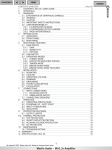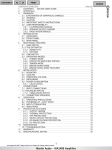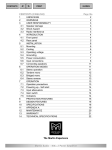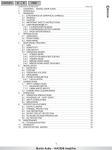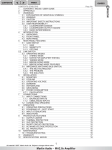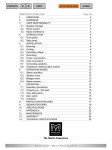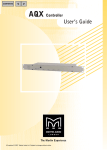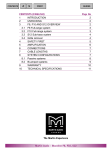Download Martin Audio E1300 Technical data
Transcript
CONTENTS PRINT < > CONTENTS (ENGLISH) CONTENTS 1 UNPACKING 2 SERIAL NUMBER 3 FEATURES 4 WARNINGS 5 CAUTION 6 USER RESPONSIBILITY Loudspeaker Damage Shock Hazard Radio Interference 7 INTRODUCTION Input Level Attenuators On/Off Switch / Front Panel Indicators Plug In Card / Module Front Panel Function Switches Rear Panel Input Sockets Output Sockets / Ground Lift Switch Mains Voltage / Selection 8 PROTECTION SYSTEMS Fuse Information 9 INSTALLATION Mounting Cooling 10 OPERATING VOLTAGE Mains Connections Grounding 11 POWER CONSUMPTION 12 INPUT CONNECTIONS Balanced / Unbalanced 13 OUTPUT CONNECTIONS 14 CONNECTING LOUDSPEAKERS 15 OPERATING MODES Stereo / Tandem (Dual mono) Input Mono Sum Bridged Mono 16 OPERATING PRECAUTIONS Powering Up / Input Attenuators / Gain Switch / Indicators 17 PROTECTION FEATURES Output Power Limiter / Amplifier Thermal Protection DC Protection Short Circuit / Over Current Protection High Frequency Protection POWER SUPPLY THERMAL PROTECTION 18 MAINTENANCE Replacement Fuses 19 WARRANTY 20 TECHNICAL SPECIFICATION E1300 Plug In Processing Modules GUIDES Page No 1 2 2 2 3 4 4 4 4 4 5 5 5 6 6 6 7 7 7 8 9 9 10 10 10 11 11 11 12 13 14 15 15 16 16 16 16 17 17 18 18 19 19 19 19 20 20 21 22 23 All material © 2007. Martin Audio Ltd. Subject to change without notice. Martin Audio – E1300 Amplifier < PRINT > GUIDES This equipment conforms to the requirements of the EMC Directive 89/336/EEC, amended by 92/31/EEC and 93/68/EEC and the requirements of the Low Voltage Directive 73/23/EEC, amended by 93/68/EEC Standards Applied 1 EMC Emission Immunity Electrical Safety EN55103 - 1: 1996 EN55103 - 2: 1996 EN60065: 1998 UNPACKING Every Martin Audio E1300 Amplifier is built to the highest standards and is thoroughly tested and inspected before it leaves the factory. After unpacking the amplifier, examine it carefully for any signs of transit damage, and inform your dealer if any such damage is found. It is suggested that you retain the original packaging so that the unit can be returned at a future date if necessary. Please note that Martin Audio and its distributors cannot accept responsibility for damage to any returned product through the use of noneapproved packaging. 2 SERIAL NUMBER Every E1300 amplifier has an individual serial number marked on the rear of the unit. Please make a separate copy of this number and quote it on any correspondence referring to the amplifier. This serial number provides us with technical data exclusive to each amplifier. 3 FEATURES 1. Plug in front panel module facility eliminating the need for external controllers 2. High frequency switching power supply, with on board intelligent control 3. Custom heat exchanger with massive surface area and turbulent flow 4. Intelligent inter-dependent logic controlled power supply and audio protection circuits 5. Dual fan 4-stage thermal control, ensuring the amplifier will provide maximum performance under any condition 6. Dual die output devices providing high current and reactive load capabilities 7. Automatic protection against severe amplifier clipping 2 All material © 2007. Martin Audio Ltd. Subject to change without notice. Martin Audio – E1300 Amplifier ENGLISH CONTENTS < PRINT > GUIDES 8. Bridgeable output stage 9. Switchable high pass filters, frequency selectable 10. Balanced XLR inputs with link outs, and dedicated sub bass outputs (when using plug in module) 11. Selectable input sensitivities and input mono sum facility 12. Speakon output sockets for Channel A, Channel B, and Bridge 4 WARNINGS Do not use this amplifier if the mains cable is damaged. Always operate this amplifier with the chassis ground wire connected to the electrical safety earth. Do not parallel or series connect an amplifier output with any other amplifier output. Do not connect the amplifier output to any other voltage source, such as a battery, mains source or power supply, regardless of whether the amplifier is turned "ON" or "OFF". Do not run the output of any amplifier back into another channels input. Do not block the air intake or exhaust ports. Do not operate the amplifier on or near any source of heat. Do not stand water or any other liquid on or near the amplifier. Do not spill or splash water, or any other liquid into or onto the amplifier. Do not operate the amplifier if liquid ingress is suspected. Do not remove top cover. Removal of the cover will expose hazardous lethal voltages and currents and may invalidate warranty. Keep this manual for future reference. 3 All material © 2007. Martin Audio Ltd. Subject to change without notice. Martin Audio – E1300 Amplifier ENGLISH CONTENTS 5 PRINT < > GUIDES CAUTION There are no user serviceable parts inside this amplifier. Removal of the cover by unauthorised personnel may invalidate warranty and will result in exposure to lethal high voltage and current. In the unlikely event of a fault developing within the E1300 refer servicing to qualified personnel only. 6 USER RESPONSIBILITY Loudspeaker Damage Many loudspeakers can be easily damaged or destroyed by overpowering, especially with the high power available from a bridged amplifier. Always check the loudspeaker continuous and peak power capability. Even if the gain is reduced by using the amplifier front panel attenuators, it is still possible to reach full power output, if the input signal level is high enough. Shock Hazard Power amplifiers are capable of producing hazardous output voltages. To avoid electrical shock, do not touch any exposed loudspeaker wiring when the amplifier is operational. See page 15 for correct connection of loudspeakers. Radio Interference A sample of this product has been tested and complies with the limits for the European Electro Magnetic Compatibility (EMC) directive. These limits are designed to provide reasonable protection against harmful interference from electrical equipment. This amplifier uses radio frequency energy and if not used or installed in accordance with these operating instructions, may cause interference to other equipment. Compliance with the (EMC) directive does not automatically guarantee non-disturbance of susceptible equipment in close proximity to this amplifier. If the amplifier is suspected of causing interference, this can be easily checked by powering the unit "ON" and "OFF", and observing the disturbance. The user can correct the interference by one or more of the following steps: 1. Increase the distance between the equipment. 2. Connect the power cable to a socket on a different circuit from that to which the affected unit is connected. 3. If a radio receiver is affected (normally only AM receivers are affected); Re-orientate the antenna. 4. Check if the affected equipment complies with the EMC limits for immunity, (CE-labelled). If not, address the problem with the manufacturer or supplier. All electrical products sold in the EC must be approved for immunity against electromagnetic fields, high voltage flashes and radio interference. 4 All material © 2007. Martin Audio Ltd. Subject to change without notice. Martin Audio – E1300 Amplifier ENGLISH CONTENTS 7 PRINT < > GUIDES INTRODUCTION Thank you for purchasing a Martin Audio power amplifier. This manual contains important information on operating your amplifier correctly and safely. Please take some time to read this manual and familiarise yourself with the advanced features of this amplifier. 1. Carry Protection Handle. Both handles can be used to carry the amplifier; they also act as a protection for the front panel and the controls. In fixed installations or where rack front covers are too shallow, they may be removed by unscrewing the retaining bolts behind the front panel. 2. Input Level Attenuators. These controls are used to set the signal input levels to Channel A and Channel B. When the controls are in the fully clockwise position the maximum gain of the amplifier can be utilised. 3. On / Off Switch. The power switch for the amplifier is located to the right hand side of the front panel. The amplifier is "ON" when the switch is Down. A red LED will illuminate to show the presence of mains power. Note: The power switch must remain accessible when the amplifier is installed. The power switch must be turned "OFF" then back "ON" to restart the amplifier after a protection shut down has occurred. (See page 18) 4. Signal Present Indicators. Adjacent to each level control are two green LED’s, which indicate input level to the amplifier. 5. -3dB Level Indicators. Adjacent to each level control are two amber LED’s, which indicate when approx half of the amplifier’s power is being delivered. 6. Max Level Indicators. These red LED’s illuminate when the full power of each amplifier channel is being delivered. 7. Power ON Indicator. This illuminates when power is connected to the amplifier and the front panel switch 3 is in the "ON" position. 8. Card Enable Indicator. This illuminates when a processing module is connected. 5 All material © 2007. Martin Audio Ltd. Subject to change without notice. Martin Audio – E1300 Amplifier ENGLISH CONTENTS PRINT < > GUIDES 9. Bridged Indicator. This illuminates when bridge mode is selected (function switch SW 5 is pushed IN). 10. Thermal Indicator. This indicates the thermal status of the amplifier. See page 19 for a full description. Plug In Card / Modules. The E1300 has the facility to accept a Martin Audio processing module. When fitted it replaces the removable panel on the front of the amplifier. It is connected to the main motherboard by a flexible ribbon cable. Front Panel Function switches. To access the E1300 function switches, remove the plug in module / front panel. There are 5 push button switches mounted on the main motherboard. SW 1 selects the high pass cut off frequency. Standard frequencies 15Hz and 30Hz. (30Hz when IN). SW 2 is high pass filter in / out. (High Pass in when IN). SW 3 selects the amplifier gain 36dB (0.775v input sensitivity) or 32dB (1.23V input sensitivity). (32dB when IN). SW 4 mono sums the inputs. (When IN). SW 5 is the Output Bridge select. When in bridge mode Channel A input should be used with Channel A gain control. (Bridged when IN). When all switches are out, the amplifier is configured unbridged, stereo, the gain is 36db (0.775v input sensitivity). The high pass filter is out and the turnover frequency is 15Hz. 6 All material © 2007. Martin Audio Ltd. Subject to change without notice. Martin Audio – E1300 Amplifier ENGLISH CONTENTS PRINT < > GUIDES Rear Panel 1. Fuse holder. The E1300 is fitted with a bayonet style 1/4 turn fuse holder. See pages 9 & 20 for fuse details and type. 2. Mains Power Connection. The E1300 is supplied with a 1.5M, 3 core captive cable. (See page 11). 3. Air Inlets. The E1300 uses forced air cooling for efficient operation. These inlets take in air which is exhausted from the front of the amplifier. 4, 5 and 6. Output Sockets. The amplifier is provided with 3 NL4 SPEAKON output sockets. Connection to the SPEAKON sockets can only be made with a SPEAKON plug. The output of Channel A, Channel B, and bridge appear on pins +1 and -1; Pins +2 and -2 are open circuit. Note: It is important that the correct polarity is observed when connecting your loudspeaker system. The positive (in phase) output must always be connected to pin +1, the negative (none phase) output should be connected to pin -1. 7. Ground Lift Switch. This switch isolates the electrical earth from the signal 0V (signal ground). When in the lift position earth currents are prevented from circulating, by inserting an R.C. network between 0V and Earth. 8. and 9. Input Sockets. 3 pin female XLR connectors are provided for signal input. 7 All material © 2007. Martin Audio Ltd. Subject to change without notice. Martin Audio – E1300 Amplifier ENGLISH CONTENTS PRINT < > GUIDES 10. Line Level Output Socket. When a processing module is fitted, left and right sub bass signals can be routed to this output. See module operating instructions for a full description. 11. and 12 Input Link Sockets. 3 pin male XLR connectors are provided which are connected in parallel with the input sockets. These can be used for "daisy chaining" the signal to other amplifiers. Mains Voltage Selection. The E1300 is dual voltage selectable; it is normally supplied pre selected for 220/240 Volt AC operation only. For use on 110/115 Volts AC, internal modifications must be made. Warning: This modification should only be carried out by an experienced service technician. Contact Martin Audio Ltd or an appointed distributor for details. 8 All material © 2007. Martin Audio Ltd. Subject to change without notice. Martin Audio – E1300 Amplifier ENGLISH CONTENTS 8 PRINT < > GUIDES PROTECTION SYSTEMS The E1300 is provided with multiple protection circuits, these include current and dissipation limiting in the output stage, plus short circuit and high frequency protection. The power supply also has its own independent, start-up and shutdown hierarchy plus short circuit and over current protection. Fuse Information 1. External mains fuse ceramic: 10 Amp Type T (H) (220-240V) 16 Amp Type T (H) (100-120V) It is essential that if the fuse needs to be replaced for any reason it is only replaced with the correct type. The correct fuse allows the E1300 to deliver full power without danger. If a fuse of lower current rating than specified is used, or with different fusing characteristics, it will blow prematurely, whilst a fuse of a higher rating than recommended, is unsafe and dangerous, and could cause fire, or catastrophic failure in the event of a fault developing within the amplifier. For details of fuse type, part numbers, and suppliers (see page 20). 2. Internal fuse 10 Amp Type T (H) In the event of this DC fuse needing to be replaced, it must be replaced with a fuse of the same type and current rating. Warning: This should only be carried out by an experienced service technician. See fuse specification page 9 & 20. CAUTION! DANGEROUS VOLTAGES MAY EXIST IN THIS AMPLIFIER EVEN AFTER SWITCHING OFF! REFER SERVICING TO QUALIFIED PERSONNEL ONLY WARNING! WAIT AT LEAST FIVE MINUTES BEFORE REPLACING FUSE 9 All material © 2007. Martin Audio Ltd. Subject to change without notice. Martin Audio – E1300 Amplifier ENGLISH CONTENTS 9 PRINT < > GUIDES INSTALLATION Mounting The amplifier is two-rack unit's high (2U) and will mount in a standard EIA 19" rack. Amplifiers may be stacked directly on top of each other; there is no need for spacing between units. If it is the intention to fill a rack with amplifiers, we recommend racking be started from the bottom of the rack. It is also recommended that rear supports be used for amplifiers, especially if used as part of a portable system. Cooling Your amplifier uses forced air-cooling to maintain an even operating temperature. All Martin Audio E series amplifiers have rear to front cooling. Never try to reverse the airflow, as the amplifier needs a pressure chamber between the fans and the heatsink and this only operates in one direction of the airflow. Warning: never rack different brands of amplifiers together with opposing airflow characteristics. Make sure that there is adequate air supply at the rear of the amplifier and that the front of the amplifier has sufficient space at the front to allow the exhaust to escape. If the amplifier is rack mounted, do not use covers or doors on the front and rear of the rack. For fixed installations with a central cooling system, and dedicated rack room, it may be necessary to calculate the maximum heat emission. See page 13. 10 All material © 2007. Martin Audio Ltd. Subject to change without notice. Martin Audio – E1300 Amplifier ENGLISH CONTENTS 10 PRINT < > GUIDES OPERATING VOLTAGE WARNING! A label above the mains power cable on the rear of the amplifier indicates the selected AC mains operating voltage. Connect the power cable only to the AC source referred to on the label. The warranty will not cover damage caused by connecting to the wrong type of AC mains. For converting a 230 volt amplifier to 115 volts or vice versa, contact Martin Audio Ltd or an approved Martin Audio dealer. Martin Audio E series amplifiers use primary switching, i.e. the mains is rectified directly before the transformer, which means that the power supply is insensitive to the mains frequency. Mains Connections The amplifier is supplied with 1.5M of un-terminated 3-core cable and should be connected as below to a suitable plug or outlet. BROWN BLUE GREEN/YELLOW - LIVE (POSITIVE +) NEUTRAL (NEGATIVE -) EARTH (CHASSIS) Once connected to a suitable AC supply, the amplifier can be started with the power switch. When you power up the amplifier it takes a few seconds to self-check. (This is known as the "soft start" sequence). The fans will start and the red power "ON" LED and red "max" power LED’s will illuminate to show the amplifier is operational. If everything is ok the “max” power LED’s will extinguish and the power LED will remain "ON". Grounding The E1300 is equipped with a ground lift switch at the rear of the amplifier. Depending on the system wiring configuration, it may be necessary to 'LIFT' the signal ground. When the signal ground lift switch is operated it interposes an RC network between chassis ground and signal 0V breaking any ground loops that may be causing hum. For compliance with the EMC directive (conducted emissions), the E1300 is provided with an AC mains filter. This requires the mains earth to be connected to ground at all times. RISK OF SHOCK! For safety reasons never operate the amplifier with the mains earth disconnected. 11 All material © 2007. Martin Audio Ltd. Subject to change without notice. Martin Audio – E1300 Amplifier ENGLISH CONTENTS 11 PRINT < > GUIDES POWER CONSUMPTION There are three ways to define the power/current consumption of the amplifier. First, the peak current draw at full sine wave power output. Under this condition the amplifier could thermally limit or blow the mains fuse, and is an unrealistic ‘normal’ use condition. To design a mains distribution system based on the current draw at full power would result in an over specified system. No music programme material requires the full steady state continuous power of an amplifier; this operating condition is only valid for amplifier bench testing. Second, the maximum expected average current under worst case conditions, which corresponds to 1/3 of full power according to the FTC standard. At this level the program material will be in a state of constant clip and is the highest power level that can be obtained without completely obliterating the program content. Lastly, the "normal operating power", as defined by EN60065 as a measurement level for approval and testing to this standard. The normal operating power is measured using pink noise, with an average output power equal to 1/8 of full power. The 1/8 power is the maximum volume music can be replayed without continuous amplifier clipping, corresponding to a headroom of 9dB's, which is very low for normal program material; 12 to 15dB’s is a more realistic figure. If operating both channels of the amplifier into a sustained 2 ohm load, protection circuits within the amplifier could be triggered due to thermal or over current protection, and the amplifier will shut down. To reset the amplifier, it must be switched "OFF" then back "ON". 12 All material © 2007. Martin Audio Ltd. Subject to change without notice. Martin Audio – E1300 Amplifier ENGLISH CONTENTS > GUIDES Power Table E1300 OUTPUT POWER E1300 MAINS INPUT POWER 1/3 POWER 1/8 POWER IDLE 8 Ohm 2X 400 680 400 117 4 Ohm 2X 720 1220 700 117 2 Ohm 2X 1000 1880 1200 117 1/3 Power level = Average power with music as programme source. The amplifier driven to clip level 1/8 Power level = Normal operating power with music as programme source, 9dB headroom Heat Power Table E1300 HEAT POWER 1/3 POWER 1/8 POWER 1/3 POWER Watts 1/8 POWER 1/3 POWER Kcal/hour 1/8 POWER BTU/hour 8 Ohm 370 300 93 78 1262 1058 4 Ohm 660 530 166 133 2252 1800 2 Ohm 1280 900 320 230 4354 3084 1/3 Power level = Average power with music as programme source. The amplifier driven to clip level 1/8 Power level = Normal operating power with music as programme source, 9dB headroom 12 INPUT CONNECTIONS Both Channel A and Channel B inputs are electronically balanced on 3 pin XLR type connectors, and wired pin 2 hot (+), pin 3 cold (-), and pin 1 Earth or SIG 0V 13 All material © 2007. Martin Audio Ltd. Subject to change without notice. Martin Audio – E1300 Amplifier ENGLISH < PRINT CONTENTS PRINT < > GUIDES The input impedance is sufficiently high to allow daisy chaining or multiple parallel input connections using the input 'Link' XLR. Balanced line (source and input): Unbalanced source with balanced input: To minimize hum in the audio, use balanced connections whenever possible. 14 All material © 2007. Martin Audio Ltd. Subject to change without notice. Martin Audio – E1300 Amplifier ENGLISH CONTENTS 13 < > GUIDES OUTPUT CONNECTIONS When a Martin Audio processing module is fitted it can be configured to output line level sub bass signals which may be fed to other amplifiers. The balanced signal appears on the 5 pin XLR connector on the rear of the amplifier. Pin Pin Pin Pin Pin 1 2 3 4 5 SCREEN CH,A + CH,A – CH,B + CH,B – The outputs of the module are not auto compensating, therefore when driving an unbalanced input use only the + output and screen. 14 CONNECTING LOUDSPEAKERS Loudspeaker connections are made via the three Neutrik NL4 Speakon connectors 4, 5, and 6. These connectors meet the EC safety requirements. They are wired as follows: Pin Pin Pin Pin -1 +1 -2 +2 Speaker negative Speaker positive No connection No connection Never connect either output terminal to ground or to some other output or input terminal For normal two-channel operation, connect each loudspeaker load across the outputs positive and ground terminals. Pay attention to loudspeaker polarity; loudspeakers connected out of polarity can degrade sound quality. 15 All material © 2007. Martin Audio Ltd. Subject to change without notice. Martin Audio – E1300 Amplifier ENGLISH PRINT CONTENTS PRINT < > GUIDES Keep the loudspeaker cables as short as possible and use good quality stranded cable. Do not use shielded wire, such as microphone or guitar cable. Remember that the loudspeaker cable robs the power of the amplifier in two ways; it increases the load impedance and also introduces resistive power losses. 15 OPERATING MODES Stereo For stereo dual channel operation ensure switch S4 (located behind the plug in card panel on the front of the amplifier) is in the "OUT" position. In this mode both channels are split and operate independently of each other, with their level attenuators controlling their respective outputs. Never connect either output terminal to ground or in parallel. Tandem (Dual Mono) For tandem (dual channel-single input) operation connect the link out of one channel into the input of the other channel using an XLR to XLR cable. Input Mono Sum To mono sum input A and B together push "IN" switch S4 (located behind the plug in module/panel on the front of the amplifier). A level drop of 6dB’s will occur if only one input is used in this mode of operation. The output connection is the same as in stereo mode. Bridged Mono To bridge the amplifier, depress switch S5 (located behind the removable panel/module on the front of the amplifier) both channels are then fed by input 'A'. The output in bridge mode appears on the dedicated 'Bridge out Speakon'. Only Channel A level attenuator and the LED's associated with Channel A are operational in bridge mode. If SW4 is depressed this will sum together input A and B which will then be fed to the bridged output stage. Pin -1 Speaker negative Pin +1 Speaker positive NB. The recommended minimum nominal impedance for bridged mono is 4 Ohms (equivalent to driving both channels at 2 Ohms) Driving bridged loads of 4 Ohms or lower with the “max” LED’s permanently "ON" may trigger protection circuits within the amplifier due to current and thermal demands. If an over current shut down occurs the power supply will shut down. To restart the amplifier the power switch must be turned "OFF" then back "ON". The input level to the amplifier must also be reduced or the power supply will shut down again. (See page 18 Protection Features). 16 All material © 2007. Martin Audio Ltd. Subject to change without notice. Martin Audio – E1300 Amplifier ENGLISH CONTENTS 16 PRINT < > GUIDES OPERATING PRECAUTIONS Make sure the power switch is "OFF" before making any input or output connections, installing a plug in module or operating any switches behind the removable panel / plug in module. Make sure that the AC mains are correct and that it is the same as that printed on the back of the amplifier. See pages 11 & 12 regarding operating voltage and power consumption. It is always a good idea to turn down the gain controls during power up as this prevents loudspeaker damage, especially if there is a high level signal present at the input. Powering Up When the amplifier is first switched on the power "ON" and "max" LED’s illuminates, it then takes a couple of seconds to self-check. If everything is OK the "max" LED’s will extinguish and the power LED will stay "ON". This is known as the "soft start" or "slow start" sequence, the fans then start and the power amplifier is operational. Input Attenuators The two input level attenuators on the front panel adjust the signal level to the respective amplifier channels. In bridged mode, only Channel A level control is used. Gain Switch The gain switch (SW3) is located behind the plug in panel / module on the front of the amplifier, when in the "OUT" position the gain of the amplifier is 36dB (input sensitivity 0.775Vrms), when in the "IN" position the gain of the amplifier is 32 dB (input sensitivity 1.23Vrms). When in bridge mode the amplifier sensitivity will remain the same in each position of SW3, but the effective output gain will increase by 6dB’s in each case, from 36dB to 42dB and from 32dB to 38dB. Most professional mixing consoles operate at a nominal level of +4dBu. Therefore use the 32dB position (SW3 switch IN). On MI or semi professional equipment that operates at a nominal 0dBu level use the 36dB-gain setting (SW3 switch OUT). Indicators The two bottom green LED's act as signal present indicators and operate when the output signal is greater than -30dB's. The yellow -3dB LED's indicate when approximately half of the power capacity of the amplifier is being utilised. The red "max" LED's indicate when the full capacity of the amplifier is being used. Protection circuits within the amplifier allow the maximum output of 17 All material © 2007. Martin Audio Ltd. Subject to change without notice. Martin Audio – E1300 Amplifier ENGLISH CONTENTS PRINT < > GUIDES the amplifier to be used without severe hard clipping. The "card enable" LED indicates when a dedicated processing module is fitted in the amplifier. The remaining red "thermal" LED indicates the temperature status of the amplifier. The E1300 is fitted with a sophisticated thermal management system. Under normal operation the thermal LED will be "OFF", if more power is demanded from the amplifier, or airflow to the amplifier is restricted the LED will start to flash to indicate an elevation in operating temperature. If no action is taken at this point the third status level will be reached, the thermal and limit LED’s will be "ON", and the amplifier will protect itself by reducing the power to the load. When the amplifier has cooled sufficiently the power will ramp back up to the previous level. If the amplifier does not cool enough or the fans fail completely, the amplifier will lock in a reduced power state until the problem is cleared. 17 PROTECTION FEATURES Every Martin Audio E series amplifier has many advanced protection features that will protect both the amplifier and the loudspeakers connected to it, should a fault condition arise. Under normal use these features are inaudible. Output Power Limiter An output limiter is included to avoid severe amplifier clipping. When an amplifier is severely overdriven, its output waveform is clipped (its peaks are squared off) - reducing the crest factor. In extreme cases, the waveform can approach that of a square wave. An amplifier is capable of producing far more power under these conditions than its normal undistorted rated power output. If the distortion exceeds 1% THD for any reason the limiter reduces the input signal proportionally. Note that, if the input signal is clipped before it reaches the amplifier, the clip limiter will not be activated and severe damage to the loudspeakers could occur. Amplifier Thermal Protection All high power amplifiers produce considerable heat as a product of power output. The E1300 is equipped with a very efficient heat exchanger and an automatic logic controlled thermal management system. When the amplifier is switched on the dual fans will start up and remain at a low idling speed. As the amplifier provides more power the fans may switch to the second cooling level. Under sustained demand for high power or when there is insufficient cooling, the third level of fan speed is reached and the red “thermal” LED on the front panel will begin to flash. If no action is taken to either reduce the power demand or increase the airflow through the amplifier, it will automatically protect itself, by reducing the power to the loudspeaker. The status of the “thermal” and “max” LED’s will change to permanently "ON" and the green and amber signal LED’s will extinguish. 18 All material © 2007. Martin Audio Ltd. Subject to change without notice. Martin Audio – E1300 Amplifier ENGLISH CONTENTS PRINT < > GUIDES When the amplifier has cooled back down to its normal operating temperature the red “max” LED’s and “thermal” LED’s will extinguish. The green and amber signal LED’s will become operational, and power to the loudspeakers will ramp up to the previous set level. DC Protection If more than ±5 volts appears on the amplifier outputs the power supply will shut down. Switch "OFF" the amplifier and check that the source of DC is not external to the amplifier i.e. controller sense lines etc. If the fault has been cleared, switch "ON" the amplifier and it should power up as normal. If the amplifier shuts down again the DC voltage has either not been cleared or the amplifier is faulty and will not power up again until it is repaired. The amplifier has to be re-set by turning the amplifier "OFF" then back "ON". Short Circuit / Over Current Protection The power supply will shut down if a short circuit appears on the amplifier outputs, or the amplifier tries to supply more current than it can provide. The amplifier has to be reset by turning the amplifier "OFF" then back "ON". If the short circuit or very low impedance load is still present at the outputs, the power supply will again shut down instantaneously. High Frequency Protection If the amplifier detects out of band high frequency, high power output signals, the power supply will shut down, protecting the amplifier and HF drive units from burnout. The amplifier has to be re-set by turning the amplifier "OFF" then back "ON", to initiate a power up sequence. Power Supply Thermal Protection In the unlikely event that both fans become blocked or fail, the amplifier will continue to operate until the power supply reaches its maximum operating temperature. At this point a thermal trip will activate to prevent permanent damage to the power supply, and the power supply will shut down. The amplifier has to cool down to its normal operating temperature before it can be re-started. The amplifier has to be turned "OFF" then back "ON" again, to initiate a power up sequence. The cause of the blockage must be removed or the fans replaced. The amplifier will not power up until the temperature has dropped to a safe level. 19 All material © 2007. Martin Audio Ltd. Subject to change without notice. Martin Audio – E1300 Amplifier ENGLISH CONTENTS 18 PRINT < > GUIDES MAINTENANCE Under normal use the amplifier should give years of trouble free service. Periodically it may be necessary to clean the inside of the amplifier. (This should only be done by qualified service personnel). If you are using your amplifiers for heavy-duty use i.e. Concert touring or industrial music, it is recommended that you have your amplifier serviced every three years, purely as a preventative measure. We recommend you do not use the amplifier in environments using "cracked oil" smoke machines, as condensed oil inside the amplifier can cause serious damage. Replacement Fuses 220V-240V 10 Amp type T (H) Martin Audio Part No. (FUSE T 10AMP) manufactured by SIBA 70-065-65 series Stocked worldwide by Farnell Electronic Components (Farnell Part No. 159232) 100-120V 16 Amp type T (H) Martin Audio Part No. (FUSE T 16AMP) manufactured by SIBA 70-065-65 series Stocked worldwide by Farnell Electronic Components (Farnell Part No. 159256) 20 All material © 2007. Martin Audio Ltd. Subject to change without notice. Martin Audio – E1300 Amplifier ENGLISH CONTENTS 19 < PRINT > GUIDES WARRANTY General The E1300 Power amplifier is warranted to be free from defects in components and factory workmanship under normal use and service, for a period of one year from the date of original purchase. During the warranty period, MARTIN AUDIO LTD or its nominated agents, will undertake to repair or at its discretion, replace this product at no charge to its owner, when failing to perform as specified, provided the unit is returned undamaged, in its original packaging, shipping pre-paid, to the factory, distributor or authorised service facility. This warranty shall be null and void, if the product is subjected to: 1. Repair work or alteration by persons other than those authorised by MARTIN AUDIO LTD or its agents. 2. Shipping accidents, act of God, war, civil insurrection, misuse, abuse operation with incorrect AC voltage, operation with faulty associated equipment, exposure to inclement weather conditions and normal wear and tear. Units, on which the serial number has been removed or defaced, will not be eligible for warranty service 3. MARTIN AUDIO LTD shall not be responsible for any incidental or consequential damages, with respect to the products warranted. MARTIN AUDIO LTD reserve the right to make changes or improvements in design or manufacturing, without assuming any obligation to change or improve products previously manufactured. This warranty is exclusive and no other warranty is expressed or implied. This warranty does not affect your statutory rights. International Please contact your supplier for this information, as rights and disclaimers may vary from country to country. Technical assistance and services International If your Martin Audio product needs repair, contact your Martin Audio dealer or distributor, or contact Martin Audio by fax or email to obtain the location of the nearest dealer or distributor. Telephone: + 44 (0) 1494 535312 Fax: + 44 (0) 1494 438669 E-mail: [email protected] www.martin-audio.com 21 All material © 2007. Martin Audio Ltd. Subject to change without notice. Martin Audio – E1300 Amplifier ENGLISH CONTENTS 20 < PRINT > GUIDES E1300 TECHNICAL SPECIFICATION INPUT IMPEDANCE 20K Ohms differential, 10K Ohms single ended INPUT SENSITIVITY Selectable 0.775mv (36dB gain) or 1.23V (32dB gain) FREQUENCY RESPONSE 17Hz - 46KHz + 0dB – 3dB POWER BANDWIDTH 10Hz - 40KHz + 0dB – 0.5dB POWER OUTPUT 400 Watts Cont Av into 8 Ohms 720 Watts Cont Av into 4 Ohms 1000 Watts Cont Av into 2 Ohms 1440 Watts Cont Av bridged into 8 Ohms OUTPUTS Impedance DC offset 22mΩ <2mV SLEW RATE 70 Volts per micro second (SIGNAL + NOISE) / NOISE RATIO >100dB 20Hz - 20KHz IEC, A weighted DISTORTION < 0.06% @ 1dB below full power POWER REQUIREMENTS Operating voltage Minimum start-up voltage Peak inrush current 230V Setting 180* – 250Vac 140Vac 11.8 Amps Current draw 4Ω Quiescent (No load) 0.9 Arms 1/8 Full power (Both channels) 4.8 Arms 1/3 Full power (Both channels) 7.2 Arms Dual voltage operation 115V (internal Links). 115V Setting 90* - 125Vac 70Vac 23 Amps 1.8 Arms 9.6 Arms 14 Arms or 230V *Note: The amplifier will operate down to the indicated mains voltage but with reduced power output. AMBIENT TEMPERATURE Maximum ambient operating temperature +40°C INDICATORS Power On, Signal Level, Bridge, Thermal, Card/Module Enable INPUT CONNECTIONS 2 x XLR with 2 x XLR parallel links Pin 2 Hot, Pin 3 Cold 22 All material © 2007. Martin Audio Ltd. Subject to change without notice. Martin Audio – E1300 Amplifier ENGLISH CONTENTS < PRINT > GUIDES SIGNAL Pin 1 Ground lifted via 470R // 100nF. Options for pin 1 open circuit, and pin 1 connected directly to electrical earth INPUT CONNECTION POWER Captive 1.5M 3-core cable OUTPUT CONNECTIONS 3 x Speakon connectors, 1 x 5 pin XLR (stereo line level sub bass out) this is only active when a processing module is fitted (minimum load impedance 1K ohms) DIMENSIONS (incl. Handles) (W) 482mm x (H) 88mm x (D) 384.5mm (W) 19ins x (H) 3.5ins x (D) 15.1ins WEIGHT 9.5Kg (20.9lbs) E1300 PLUG IN PROCESSING MODULES System specific Martin Audio plug in modules are available for use with the E1300 to eliminate the use of separate stand-alone controllers*. To fit the module, first switch "OFF" the amplifier and remove the power connection to the amplifier. Unscrew the two retaining bolts that hold the removable panel on to the front of the amplifier. Unplug the grey ribbon cable from its 'park' position SK2 on the motherboard and plug it into the header on the module. If any changes are required to the function switches they should be done now before the module is fitted. It is recommended that the high pass filter is switched "IN" and set for 30Hz when using the module (SW1 and SW2 both pushed IN). Refit the module into the front of the amplifier ensuring the ribbon cable is folded under and is not trapped or stretched. Reinstate the power connection to the amplifier and switch "ON". The green Card Enable LED on the front panel should now be illuminated. The selected filtered and equalised signals will now appear on the outputs of the amplifier, and on the rear 5 way line level out, sub bass connector. * Refer to E1300 module user guide for detailed set up information. 23 All material © 2007. Martin Audio Ltd. Subject to change without notice. Martin Audio – E1300 Amplifier ENGLISH CONTENTS CONTENTS PRINT < > E1300 GUIDES Amplifier Please Click here to return to main menu Please Click here to visit our website The Martin Experience Century Point, Halifax Road, Cressex Business Park, High Wycombe, Buckinghamshire HP12 3SL, England. Telephone: +44 (0)1494 535312 Facsimile: +44 (0)1494 438669 Web: www.martin-audio.com E-mail: [email protected] All material © 2007. Martin Audio Ltd. Subject to change without notice. CONTENTS PRINT < > E1300 GUIDES Amplifier User’s Guide ENGLISH The Martin Experience All material © 2007. Martin Audio Ltd. Subject to change without notice.

























